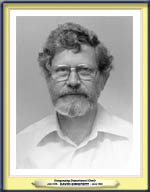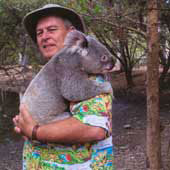The UCSB Department of Geography’s joint PhD program with the Department of Geography at San Diego State University is distinctive in that it brings together two outstanding departments that complement each other. California State Universities do not offer stand-alone doctoral programs. The joint doctorate program thereby provides mutual benefits for two of the strongest research-oriented Geography departments in the US, insofar as it increases SDSU’s attractiveness to students by permitting them to pursue a doctorate, and, in turn, allows UCSB to increase its exposure to a more diverse set of students. SDSU students spend a minimum of one year on each campus and normally start and finish their work at SDSU.
The idea of establishing a joint PhD program in Geography between UCSB and SDSU evolved from preliminary negotiations between Dr. David McArthur (SDSU) and Dr. Reginald Golledge (Chair of UCSB Geography at that time). McArthur had been a graduate student in Geography at the University of Canterbury (NZ) when Golledge taught there in the early 1960s, so the negotiations took on a personal note from the start. But progress was slow. There were only five other joint programs at SDSU at that time, and this suggestion was at first negatively viewed by UC officials.
The mid 1980s saw a number of meetings regarding the program, both at UCSB and at SDSU. The Chair at SDSU, Ernest Griffin, pursued the idea very vigorously on his campus. At UCSB, David Simonett had become Graduate Dean, and, together with a series of Chairs (Reg Golledge, Rick Church, Ray Smith, and Jack Estes), shouldered the burden of convincing UCSB and UC systemwide administrators that the idea was feasible and could benefit both institutions. The idea was strengthened by the appointment of several of UCSB’s best PhD graduates to SDSU, including Doug Stow, Janet Franklin, and Serge Rey.
When the final agreement was signed in 1988, it was based on a slow, monitored growth process for the SDSU program. Initial enrollment was to be limited to seven students, four in the Human Geography area and three in Physical Geography. Over the years, this has changed, and SDSU now admits its top applicants, regardless of area of interest. The emphasis on Human Geography reflected complementary strengths of the two departments, with SDSU traditionally emphasizing regional Urban and Cultural Geography (UCSB had virtually no offerings in these areas), and UCSB offering theoretical and technical emphases to its urban and behavioral programs.
Progress in obtaining the Joint Program was facilitated by the energetic drive of David Simonett and the supporting pressure from both SDSU Chairs (Griffin and Agaudo) and various UCSB Chairs. But the entire department at each place actively participated in all negotiations.
The joint PhD Program officially began in 1991, but its formal origins go back to 1988 when both institutions “agreed to agree” to explore the idea: “The basic aim of our program will be to produce geographers who are capable of working on the cutting edge of geographic research in terms of both their systematic and techniques specializations…Approval of a joint Ph.D. program in geography between our departments will result in demonstrable benefits of the University, the State of California, and the discipline of geography” (from a letter of May 3, 1988 by Ernst Griffin, SDSU Chair of the Department of Geography, to James Cobble, Dean of the SDSU Graduate Division, justifying permission to negotiate with UCSB).
The formal proposal was drawn up in December of 1988, the final details were hammered out in 1989, the University of California’s Office of the President granted final approval of the proposal in October of 1990, and the joint PhD program officially began in 1991. Key UCSB personnel at that time included Teresa Everett, Grad Program Assistant; Libe Washburn, Graduate Advisor; Keith Clarke, Chair; and David Fishman, Graduate Division, while key SDSU personnel at that time included Bonnie Golden; Jean Colborn; Doug Stow, Joint Program Coordinator; and Edward Aguado.
Stuart Phinn received the first PhD as a result of the Joint Program in 1997 with a dissertation titled “Remote Sensing and Spatial Analytic Techniques for Monitoring Landscape Structure in Disturbed and Restored Coastal Environments.” Thirty other PhDs have been granted in the Joint Program since then, and SDSU’s Geography Joint Doctoral Program was ranked number 7 in the United States by the 2007 Chronicle of Higher Education (which, at the time, ranked UCSB number 2, behind UCLA).
Editor’s note: Professor Reginald Golledge dictated most of the material for this article to Bill Norrington in 2008, based upon his own recollections, personal records, and private correspondence.







